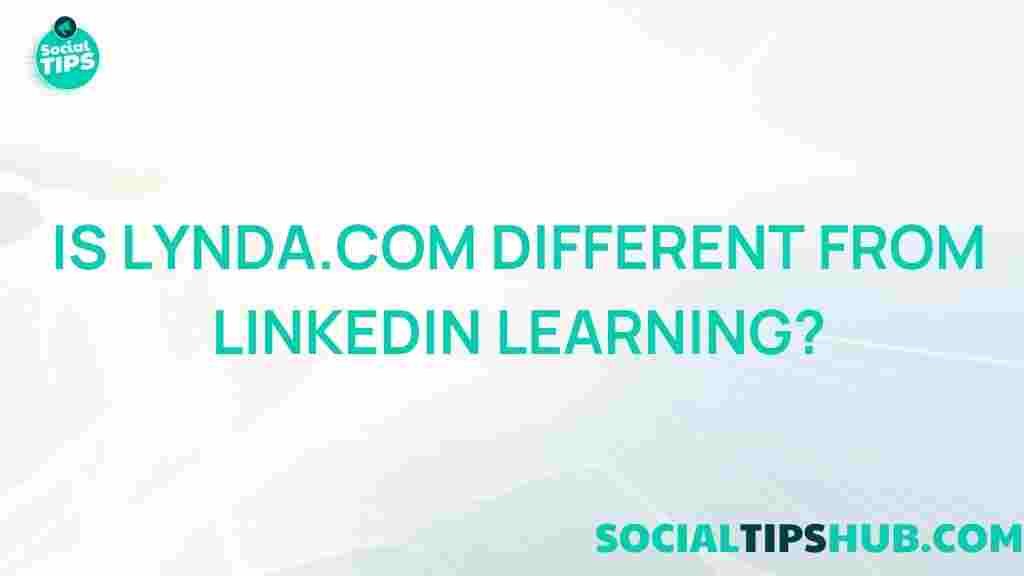Lynda.com: Uncovering the Differences Between Lynda.com and LinkedIn Learning
In today’s fast-paced world, continuous learning has become essential for personal and professional growth. With the rise of online learning platforms, individuals are seeking effective resources to enhance their skills. Two popular platforms in this domain are Lynda.com and LinkedIn Learning. While they share a common history and purpose, there are significant differences between them. This article aims to uncover these differences, helping you make an informed choice about which platform suits your needs best.
Understanding Lynda.com
Lynda.com, founded in 1995 by Lynda Weinman, started as a site dedicated to providing high-quality video courses on software development, design, and other professional skills. Over the years, it grew immensely, becoming a go-to resource for individuals looking to expand their knowledge. In 2015, Lynda.com was acquired by LinkedIn and eventually rebranded as LinkedIn Learning, integrating its vast library into LinkedIn’s ecosystem. However, many users still refer to the platform as Lynda.com, leading to some confusion.
The Transition to LinkedIn Learning
After the acquisition, the transition from Lynda.com to LinkedIn Learning brought significant changes to the platform. Here’s a step-by-step look at what this transition involved:
- Branding Changes: Lynda.com was rebranded as LinkedIn Learning, which reflects its integration with LinkedIn’s professional networking platform.
- Content Expansion: LinkedIn Learning expanded the course library, offering a broader range of topics, including business, technology, and creative skills.
- Personalized Learning: LinkedIn Learning uses algorithms to suggest courses based on user profiles, interests, and career paths.
- Integration with LinkedIn: Users can showcase completed courses on their LinkedIn profiles, enhancing their professional visibility.
Comparing Course Offerings
One of the most crucial factors to consider when choosing between Lynda.com and LinkedIn Learning is the course offerings. Both platforms provide extensive libraries, but their content focus and organization differ:
- Course Categories:
- Lynda.com: Initially focused on creative and technical courses, covering topics such as graphic design, photography, and programming.
- LinkedIn Learning: Broader categories including leadership, management, marketing, and sales, appealing to a wider audience.
- Content Quality: Both platforms maintain high-quality production standards, but LinkedIn Learning benefits from updated courses that align with current industry trends.
- Course Length: Lynda.com offered traditional course lengths, while LinkedIn Learning includes shorter, more focused content designed for busy professionals.
User Experience and Interface
The user interface plays a significant role in how effectively learners can navigate and engage with the content. Here’s how the two platforms compare:
- Lynda.com: The original platform featured a straightforward layout, making it easy for users to find courses. However, it lacked some advanced features present in modern learning platforms.
- LinkedIn Learning: The interface is sleek and user-friendly, offering personalized dashboards, course recommendations, and integrated social features for user interaction.
Pricing Structures
Understanding the pricing models of both platforms is essential for potential users. Here’s a breakdown of their pricing:
- Lynda.com: Initially, users could purchase courses individually or subscribe for unlimited access. Prices varied depending on the course length and complexity.
- LinkedIn Learning: Currently, LinkedIn Learning operates on a subscription model. Users pay a monthly fee for access to the entire course library. Discounts are often available for annual subscriptions.
Certification and Credentials
Both Lynda.com and LinkedIn Learning offer certificates of completion, but there are differences in how these are perceived:
- Lynda.com: Certificates from Lynda.com were well-regarded in certain industries but lacked formal accreditation.
- LinkedIn Learning: The integration with LinkedIn adds credibility, as users can display their certificates directly on their profiles, increasing visibility to potential employers.
Learning Styles and Formats
Different learners have varying preferences when it comes to absorbing information. Here’s how each platform accommodates these styles:
- Lynda.com: Courses often included extensive video content with supplementary resources like exercise files and quizzes.
- LinkedIn Learning: Emphasizes bite-sized learning, with many courses broken into shorter segments, allowing for flexible, on-the-go learning.
Mobile Accessibility
In an age where mobile devices dominate, the accessibility of learning platforms on smartphones and tablets is crucial. Here’s how each platform fares:
- Lynda.com: The mobile app was functional but lacked some features available on the desktop version.
- LinkedIn Learning: The mobile app is robust, offering a seamless experience, allowing users to download courses for offline viewing and receive personalized notifications.
Community and Support
Having access to a supportive community can enhance the learning experience. Here’s what each platform offers:
- Lynda.com: Users could interact through forums and comment sections, but community engagement was limited.
- LinkedIn Learning: Leverages LinkedIn’s vast network, allowing users to connect with other learners, share experiences, and seek advice.
Troubleshooting Tips
Users may encounter various issues while navigating these platforms. Here are some common troubleshooting tips:
- Difficulty Accessing Courses: Ensure you are logged in to your account. If problems persist, try clearing your browser’s cache or using a different browser.
- Playback Issues: Check your internet connection. If videos are buffering, consider lowering the playback quality in the settings.
- Subscription Issues: If your subscription isn’t recognized, verify your payment method and account status.
Conclusion
In summary, while Lynda.com and LinkedIn Learning originated from the same foundation, they have evolved into distinct platforms. Lynda.com laid the groundwork for online learning with its extensive course library and focus on creative skills. In contrast, LinkedIn Learning has expanded upon this foundation, integrating personalized learning experiences, broader course offerings, and enhanced community engagement.
Choosing between Lynda.com and LinkedIn Learning ultimately depends on your individual learning preferences, career goals, and the specific skills you wish to develop. If you are looking for a platform that offers a vast array of courses, personalized recommendations, and easy integration with a professional network, LinkedIn Learning may be the better choice. However, if you are more interested in traditional learning formats and specific creative courses, Lynda.com remains a valuable resource.
For more information on online learning platforms, you can visit Online Learning Resources or check out the latest updates on LinkedIn Learning.
This article is in the category Reviews and created by SociaTips Team





